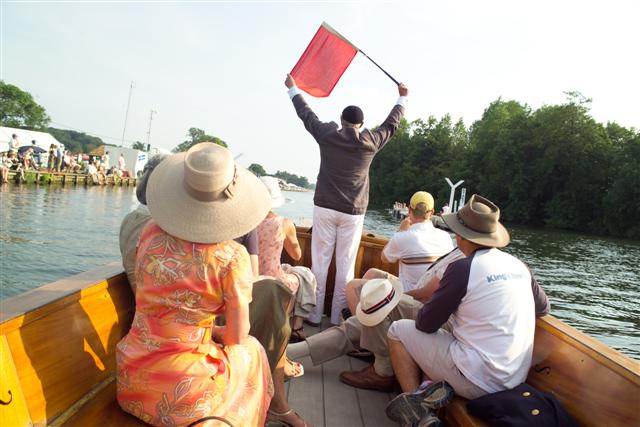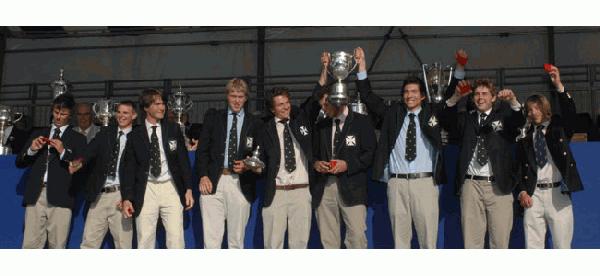 Today is the first of five days of the Henley Royal Regatta, the rowing world’s equivalent of Wimbledon or Lords. It has been part of Britain’s summer social calendar since 1839 and it has been little altered over the last one and three quarter centuries. Two crews battle side by side along 2,112 metres of river followed by an umpire in a beautiful wooden launch and watched from the bank by tens of thousands of spectators. Because rowing is essentially someone sitting on a seat going backwards as fast as they can it has, like cricket, endless records and silly names though, unlike cricket, most races are completed in under ten minutes. Just occasionally a race is won in such a spectacular way that it joins the ranks of Henley legends. Ten years ago this year one such race captured everything that is magical about the regatta and I was there to witness it. Here is the story:
Today is the first of five days of the Henley Royal Regatta, the rowing world’s equivalent of Wimbledon or Lords. It has been part of Britain’s summer social calendar since 1839 and it has been little altered over the last one and three quarter centuries. Two crews battle side by side along 2,112 metres of river followed by an umpire in a beautiful wooden launch and watched from the bank by tens of thousands of spectators. Because rowing is essentially someone sitting on a seat going backwards as fast as they can it has, like cricket, endless records and silly names though, unlike cricket, most races are completed in under ten minutes. Just occasionally a race is won in such a spectacular way that it joins the ranks of Henley legends. Ten years ago this year one such race captured everything that is magical about the regatta and I was there to witness it. Here is the story:
Sunday 8 July 2007 and the market town of Henley-on-Thames is enjoying a warm afternoon. On the Buckinghamshire bank of the River Thames the scene is one of colour, pageantry and tradition: blue and white striped boat tents marshaled neatly between the pink and cream Leander Club hard up against Henley Bridge, and the white marquees housing the grandstands and Stewards enclosure on the downstream side. It is finals day of the regatta, the day when lives are changed forever by the outcome of an individual race. At 3:50pm two crews of nine boys line up at the start, next to the lozenge shaped island in the middle of the river crowned by an elegant temple designed by the 18th century English architect, James Wyatt. The umpire is standing in a handsome launch, arms raised holding a red flag vertically above his head waiting for the two coxes to indicate that their crews are all set. ‘Are you ready?’ He sweeps the flag down sharply. ‘Go!’ Sixteen blades dip into the water. They are off.
Upwards of 100,000 people attend Henley Royal Regatta each July. It is an event caught in a bubble of history with echoes of a bygone era everywhere: fine hats, striped blazers, picnics in the car park come rain or shine, decorated launches bobbing on the white booms that line the course, Pimms jugs clinking with ice, champagne and oysters, a brass band playing military tunes, and all the while a titanic battle is being fought on the water. Brentwood had dispatched the favourites, Eton, in the semi-finals the day before and Shrewsbury had beaten Radley in a slower time.There is expectation and excitement all along the river bank – not least in the Stewards’ Enclosure where nervous parents fidget, check their watches, exchange anxious glances and wonder why the commentator has not mentioned the race yet. But patience. Then the deadpan announcement over the loudspeaker: The final of the Princess Elizabeth Challenge Cup is in progress between Brentwood College on the Berkshire station and Shrewsbury School on the Buckinghamshire station. Brentwood College are the Canadian National School Champions. No mention of Shrewsbury’s pedigree.
At the end of the island, both crews rating forty-two, Brentwood College lead Shrewsbury School by half a length. Forty strokes in from the start and the Canadians already have a half-length lead. Six minutes to go. The grandstand is full of Shrewsbury supporters. There is barely a free seat, the atmosphere tense. Elsewhere people are milling around the bars and chatting. Henley is, after all, a great social event. It marks the end of the summer season, after Ascot, and coincides with Wimbledon.
At The Barrier, Brentwood College maintain their lead of half a length over Shrewsbury School. Time to The Barrier, 1 minute 58 seconds. A buzz. One second faster than yesterday. The Barrier is one of two points where intermediate times are taken, times that later will be scrutinised, compared, delighted at or despaired over. The spectators downstream can see the action first. Crowding along the river bank they get close-up views of the two crews battling it out in the early stages of the race.
 The next timing point is Fawley. Now there is a change: At Fawley, Brentwood College’s lead over Shrewsbury School has been reduced to a quarter of a length. The grandstand is in spasm, spectators begin to move towards the river bank sensing a spectacle. Downstream the shouting has increased and the excitement is palpable. Can the home crew crack the Canadians? At The Three-Quarter Mile Signal Brentwood School led Shrewsbury School by 2 feet. The grandstand is on its feet, a roar is moving up the bank like a giant wave. Half the race gone. At the Mile Signal, Shrewsbury School had taken the lead. Wild elation but fear too. The Canadians were not about to give up and Shrewsbury supporters knew that. ‘We could see them now and it looked hell’, wrote housemaster Martin Humphreys to crew member Tom Hanmer’s parents. ‘Shrewsbury on the far side pounding away, looking a bit scrappy and tired, to be honest. Brentwood on the near side and neat and long. When they came past us Shrewsbury had a quarter of a length lead, but I could see the Canadians were eating into it with every stroke. This was grim.’ At the progress board the crews are level. Just metres from the finish …
The next timing point is Fawley. Now there is a change: At Fawley, Brentwood College’s lead over Shrewsbury School has been reduced to a quarter of a length. The grandstand is in spasm, spectators begin to move towards the river bank sensing a spectacle. Downstream the shouting has increased and the excitement is palpable. Can the home crew crack the Canadians? At The Three-Quarter Mile Signal Brentwood School led Shrewsbury School by 2 feet. The grandstand is on its feet, a roar is moving up the bank like a giant wave. Half the race gone. At the Mile Signal, Shrewsbury School had taken the lead. Wild elation but fear too. The Canadians were not about to give up and Shrewsbury supporters knew that. ‘We could see them now and it looked hell’, wrote housemaster Martin Humphreys to crew member Tom Hanmer’s parents. ‘Shrewsbury on the far side pounding away, looking a bit scrappy and tired, to be honest. Brentwood on the near side and neat and long. When they came past us Shrewsbury had a quarter of a length lead, but I could see the Canadians were eating into it with every stroke. This was grim.’ At the progress board the crews are level. Just metres from the finish …
 The two boats cross the line neck and neck. Then there is silence. The commentary ceases and the Finish Judge has to make his call. The wait seems interminable, time stands still. Then: The result of the Final of the Princess Elizabeth Challenge Cup was that Shr …. No need for the rest: the name of the winning crew is always announced first. The grandstand explodes in ecstasy … the verdict, one foot. More cheering. The narrowest, the shortest, the tiniest of winning margins imaginable, less than a sixtieth of the length of the boat.
The two boats cross the line neck and neck. Then there is silence. The commentary ceases and the Finish Judge has to make his call. The wait seems interminable, time stands still. Then: The result of the Final of the Princess Elizabeth Challenge Cup was that Shr …. No need for the rest: the name of the winning crew is always announced first. The grandstand explodes in ecstasy … the verdict, one foot. More cheering. The narrowest, the shortest, the tiniest of winning margins imaginable, less than a sixtieth of the length of the boat.
For Brentwood College a bitter blow. To be a member of a losing crew, however epic the race, there are no prizes. For the boys of the winning crew and their parents, unsurpassed joy, a matter of lifetime pride and for one man in particular this is a sweet victory. Eighty-three-year-old Michael Lapage watched his grandson, Patrick, help to win this great battle. Nearly seventy years earlier, on the same stretch of river, Michael had won silver for Great Britain in the 1948 Olympic Games. The legacy of a Henley win is a long one. It unites generations and brings tears to the eyes of the strongest of men.
Five years later Patrick was rowing in the final of the Ladies Challenge Plate, this time for Harvard University against Britain’s Leander Club. From where I was standing close to the finish it was impossible to say who had won the race after six minutes of another titanic battle. The announcement came after what seemed like an age. The result of the Final of the Ladies Challenge Plate was that Harvard University of the United States of America beat Leander Club. The Verdict: one foot. Now what are the chances of that happening to the same young man five years apart?
I am looking forward with eager anticipation to this year’s Henley Royal Regatta and hoping for some more history to be made and to watching grown men cry.





